Grow pumpkins
Growing pumpkins takes more space than most vegetables, but if you have the space, it’s straightforward and very satisfying. Other members of the pumpkin family (aka the ‘cucurbits’) are melons, pumpkins and squash, gourds, zucchini, cucumbers, and gherkins. All have similar requirements.
| 1 | Late October or early November is pumpkin planting time. This rather narrow window of opportunity is because we must wait until the soil has warmed and the risk of frost is over before planting frost tender cucurbits, and pumpkins require four to five months of warm weather to reach maturity, so the sooner they are planted, the better. Cucumbers and zucchini grow faster, but early planting is still preferable if you want to avoid the worst of the mildew that arrives in hot summer weather. |
| 2 | Choose an open sunny position with shelter from wind. |
| 3 | While you wait for warm weather, prepare the soil with ample compost and fertiliser. Cucurbits thrive in rich, well-drained soil with plenty of organic matter. Add three or four bucket loads of compost for each plant, more if your soil is heavy or sandy. Mix in fertilisers such as well-rotted organic animal manure, blood and bone, general garden fertiliser, or three month controlled release fertiliser. Pumpkins grow best with a balanced fertiliser containing potassium. Go easy on those that are mainly nitrogen. |
| 4 | Start your pumpkins from seed or individually potted seedlings, which arrive in garden centres around Labour weekend. The best pumpkins are grown from F1 hybrid seed. Beware, a seedling arising from last season’s tasty F1 hybrid pumpkin are unlikely to inherit the same desirable traits. This is why self-sown pumpkins (the ones that pop up in your compost heap) usually taste inferior, and can be a disappointing waste of valuable garden space. |
| 5 | In cooler climates look for fast maturing squash varieties. There are also bush varieties, which take less space in the garden. Compact varieties need a square metre of space, while trailing varieties will spread 2 to 3 metres. |
| 6 | When planting cucurbit seedlings from the garden centre, take care not to disturb the young roots. |
| 7 | Alternatively, sow seed directly into the garden, avoiding transplanting shock. Sowing seed in a small mound assists germination as it improves drainage and raises temperature slightly. Sow 3 or 4 seeds per mound, about 2 - 3cm deep. Water gently. Don't over water as this inhibits germination. Once germinated, carefully pull out the weakest seedlings, leaving the strongest one or two seedlings to grow on. |
| 8 | As the seedlings grow, keep the soil moist and free of weeds. Liquid fertilisers are also beneficial, including the liquid from your worm farm. |
| 9 | Covering the ground around your pumpkins with straw or layers of newspaper helps conserve moisture, suppress weeds, and protect the fruit. |
| 10 | Pumpkins and squash are harvested when the vine has shrivelled and before the first frost. Near the end of the growing season, remove foliage shading fruit to speed up ripening. |
| 11 | Pumpkins are ripe if they make a hollow sound when gently tapped with a knuckle. At this stage the foliage is dying off, the stem has started to crack and the pumpkin has a hard shell-like skin that resists puncturing when pressed with a fingernail. |
| 12 | Once pumpkins are removed from the vine, the colour stops developing. Never pull the fruit from the vine. Cut with a sharp knife or secateurs, leaving a 10cm piece of stem. Don't carry pumpkins by the stem as it might break off damaging fruit and reducing the storage life. Treated well, they can feed the family over winter, for up to six months after harvest. |
| 13 | After harvesting, leave pumpkins to dry in an open sunny position for 2 weeks. This ‘curing’ hardens the skin, heals wounds and means they’ll keep for longer. If frost threatens, cover them with straw or frost cloth. |
| 14 | Store pumpkins in a cool, dark, airy place, ideally at about 15°C for up to 6 months. Don’t stack pumpkins. Stand them upright in single rows. Check regularly and throw away any that are showing signs of decay. |
TIPS:
- Most cucurbits, except the heaviest melons and pumpkins, are suitable for growing over fences, old sheds or arches. This means even the smallest garden can accommodate cucumbers or courgettes. It also keeps fruit off the ground and well aerated, reducing the risk of disease.
- To help pumpkins last longer in storage, wipe them clean with a weak (10%) bleach solution.

4-Jan-2023
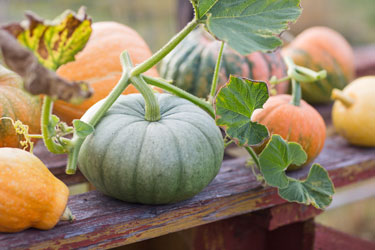
A range of pumpkins recently harvested and drying.
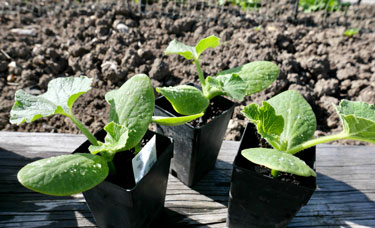
Pumpkin seedlings grown from seed.
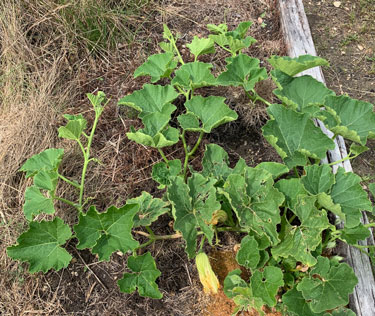
Pumpkins like to sprawl so give them plenty of room.
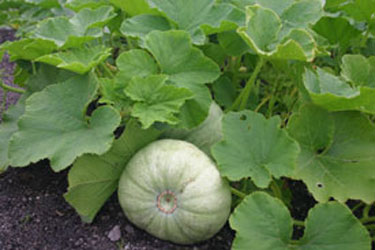
Nearly ready to harvest.
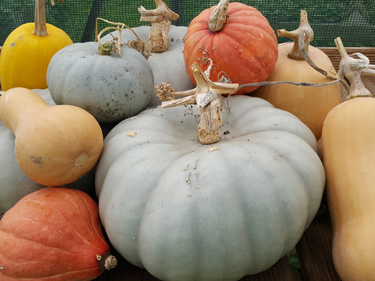
Dry and ready to store.

